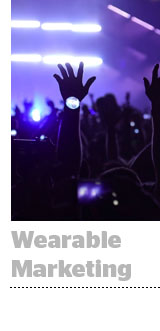
Aside from dedicated fans, most people who show up to a concert never hear from the band again. That fleeting relationship poses a challenge for musicians. How can they get people to come to their next concert? Or buy merch?
Hurdl is solving that problem with connected LED wristbands, which live event attendees activate using their mobile phones. After a show, the band can thank fans for coming via text, and then later send additional messages about upcoming shows or a link to buy merchandise.
“We are the only LED wearable that starts a marketing conversation,” said Hurdl founder Betsy McHugh, a former tour marketing manager. “We are building out a marketing system that live events can use to find these customers.”
McHugh founded the company in 2015 with $4 million in seed funding.
“There was no way for the artists I was managing to have a direct dialogue with the fans,” McHugh said. “They all had challenges talking directly to the consumers, either at the venue or continuing that conversation afterwards.”
While musicians like Taylor Swift see the value in creating a direct relationship with fans – and launch fan clubs to do just that – most musicians can’t create fan clubs at scale. Plus, many artists want to connect with casual fans, not just card-carrying members.
As a result, live bands often can only reach fans through the ticketer. Even then, only a fraction of the people in a given audience have directly paid their own way, since most bookings are for multiple tickets. Plus, a portion of people resell their tickets, so purchase data may not reflect who actually ends up at the show.
“If there are 40,000 people going to a Taylor Swift concert, ticket sellers know 10% of those people. Maybe 4,000 people got an email, and then 5% of people open that email. That’s our industry standard right now,” McHugh said.
In contrast, Hurdl claims that as many as 75% of people at a concert activate their wearable. They text a code, which then sends a radio frequency signal that activates a chip in the wearable. Concertgoers answer a short survey before activation, allowing Hurdl to capture data that it then shares with the band.
Hurdl’s client list includes deadmau5, the Dallas Mavericks, AT&T and Why Don’t We.
One client, for example, asked about what gaming consoles attendees used and brought that data to Xbox in order to secure a partnership.
The poll data also informs the show experience. “We can ask ‘Have you ever served in the military?’ And light up only the people who served, and say, ‘Thank you for serving,’” McHugh said.
Post-show, Hurdl can match its audience data against Facebook and other platforms to show bands how many attendees “like” their page, for example.
Using live event data can boost performance. In one instance, retargeting using information from viewers who opted in increased conversions by 364%.
Hurdl makes money through licensing of its platform. Although arrangements differ, Hurdl will often contribute part of the cost of the concert wearable. Then, bands or sports teams pay a SaaS fee in order to access the platform and send out marketing messages.
What if light-up wristbands fall out of fashion? Hurdl’s model could work with multiple types of wearables.
“There is such an identity problem in live events,” McHugh said. Hurdl’s betting that wearables are sticky enough that fans and artists will keep opting in. “Once you have that experience from a fan perspective and an artist perspective, you go backwards if you don’t have it.”
This post was syndicated from Ad Exchanger.


More Stories
The Tuesday Club hosts Women’s Work’s In(visible) exhibition in Tāmaki Makaurau
Under Armour Taps Estée Lauder Exec to Lead AI and Analytics
Lani Jamieson joins D3 to shape the next chapter of its growth